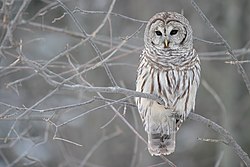Barred owl
| Barred Owl | |
|---|---|

| |
| Scientific classification | |
| Kingdom: | |
| Phylum: | |
| Class: | |
| Order: | |
| Family: | |
| Genus: | |
| Species: | S. varia
|
| Binomial name | |
| Strix varia | |
The Barred Owl, Strix varia, is a large typical owl. It goes by many other names, including eight hooter, rain owl, wood owl, and striped owl, but is probably known best as the hoot owl.
Distribution and habitat
Its breeding habitat is dense woods across Canada, the eastern United States and south to Central America; in recent years it has spread to the western United States. The Barred Owl's nest is often in a tree cavity; it may also take over an old nesting site used by a crow or squirrel. It is a permanent resident, but may wander after the nesting season.
In recent studies, suburban neighborhood has been proving ideal for the barred owls. Using transmitters, the scientist found that their population actually increased faster in the suburban setting then those in the old growth forest. So far, the only main danger to the owls are moving cars that it runs into. But the new offsprings offset that death due to the impacts from cars and disease.[1]
Description

The adult is 44 cm long with a 112 cm wingspan. It has a pale face with dark rings around the eyes, a yellow beak and brown eyes. It is the only typical owl of the eastern United States which has brown eyes; all others have yellow eyes. The head is round and lacks ear tufts, a distinction from the Short-eared Owl. The upper parts are mottled gray-brown. The underparts are light with markings; the chest is barred horizontally while the belly is streaked lengthwise. The legs and feet are covered in feathers up to the talons.[2]
Behavior and ecology

Barred Owls may be partly responsible for the recent decline of the Northern Spotted Owl, native to Washington, Oregon, and California. Since the 1960s, Barred Owls have been expanding their range westward from the eastern US, perhaps because manmade changes have created new suitable habitat in the west.[1] When Spotted Owls and Barred Owls share the same environment, the latter are generally more aggressive and outcompete the former, leading to decreased populations of the native owls.[2]
Feeding habits
The diet of the Barred Owl consists mostly of mice of many species, but it also feeds on rabbits, chipmunks, foxes, possums and also birds such as grouse and doves. It occasionally wades into water in order to capture fish or terrapins.[2]
The Barred Owl hunts by waiting on a high perch at night, or flying through the woods and swooping down on prey. It generally hunts near dawn or dusk, though it may also hunt on cloudy days. It may fly even in full daylight when disturbed. Of the North American owls, it is the species most likely to be active during the day, especially when raising chicks.[2]

Vocalization
When agitated, this species will make a buzzy, rasping hiss. The usual call is a series of eight accented hoots ending in oo-aw, with a downward pitch at the end. It is noisy in most seasons. It calls sometimes during the day, but generally at night. This owl may be displaced from more open woods by the Great Horned Owl.
References
- ^ Owls Get Wise to Better Life in Cities, Jeanna Bryner, LiveScience Staff Writer, 2007
- ^ a b c Terres, J. K. (1980). The Audubon Society Encyclopedia of North American Birds. New York, NY: Knopf. p. 665. ISBN 0394466519.
- Template:IUCN2006 Database entry includes justification for why this species is of least concern.
External links
- Mystique of the Hoot Owl
- Audio clip of a barred owl call (in Audacity Audio Block format: most browser media plugins and 3rd party media players will recognize it)
- Barred Owl - Strix varia - USGS Patuxent Bird Identification InfoCenter
- Barred Owl Species Account - Cornell Lab of Ornithology
- Barred Owl Information - South Dakota Birds and Birding
- Short Video of a Barred Owl in North Carolina - Stellar Media Video
